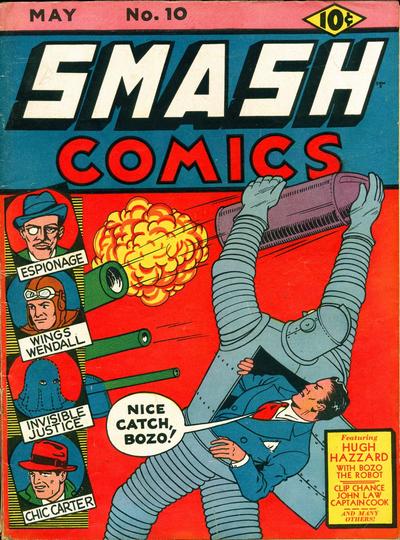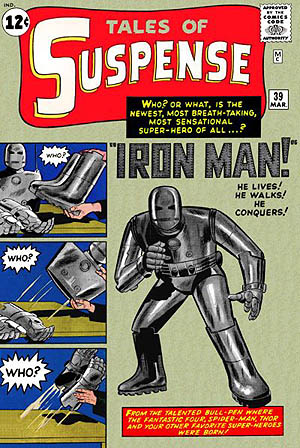Eisenhower warned about the War Machine. He called it the military industrial complex, and three days before handing the Oval Office to Kennedy, he said we must guard against its acquisition of unwarranted influence and the disastrous rise of its misplaced power.
Stan Lee wasn’t listening.
Or if he was, he took it as a challenge.
“I gave myself a dare,” says Lee. “The readers, the young readers, if there was one thing they hated, it was war, it was the military. . . So I got a hero who represented that to the hundredth degree. He was a weapons manufacturer, he was providing weapons for the Army . . . I thought it would be fun to take the kind of character that nobody would like, none of our readers would like, and shove him down their throats . . .”
Thanks, Stan.
Marvel later retooled Iron Man into a literal War Machine with James Rhodes, a high tech soldier taking orders in the military’s chain of command, something Tony Stark weapons manufacturer steered clear of.
But Tony wasn’t the first Iron Man.
Neither was the 1939 Bozo the Iron Man. George Brenner built him for Quality Comics. Originally a mad scientist’s robot minion, he was dubbed “Bozo” by Hugh Hazzard, the playboy detective who ended his crime spree and reprogrammed him into a sidekick. DC pulled his plug in 1956 when they bought Quality.
Stan Lee pulled the name off the scrap heap and handed it to Marvel second-string artist Don Heck in 1962. Bozo was big enough for Hugh to crawl inside, but Heck drew a modern-day knight in a suit of electromagnetic armor. Like the Tin Man of Oz, he also has heart problems. Remove the chest plate, and Tony’s stops. Heck liked to draw the playboy industrialist sitting around hotel rooms, plugged into wall jacks as he unglamorously recharged.
He eventually upgraded to an implant, which makes him a cyborg too. Like the Automaton. The first movie cyborg, from Harry Houdini’s 1920 silent serial The Master Mystery. A mad scientist removes his brain and wires it into a robot. It was supposed to be a scary, Frankenstein-like monster, but based on the photo stills, the costume designer could have worked for Sesame Street.
Also, the cyborg thing is a hoax. The Automaton is just a clunky metal suit, same as Heck’s, before Steve Ditko refurbished it.
If the 1920s seem like a long leap to find the original Iron Man, then charge your rocket boots. Next stop is the 1590s.
The first Man of Iron was soldered by Edmund Spenser in his epic poem The Faerie Queene:
“His name was Talus, made of yron mould,
Immoueable, resistlesse, without end.”
If you’re rusty on Renaissance English, that’s “iron mold,” “immovable,” and “resistless,” all War Machine synonyms. Talus’ other superpowers include speed (“him pursew’d so light, / As that it seem’d aboue the ground he went”), invulnerability (though a bad guy “streight at him with all his force did go,” Talus was “mou’d no more therewith, then when a rocke / Is lightly stricken with some stones throw”), and strength (“But to him leaping, lent him such a knocke, / That on the ground he layd him like a senseless blocke”). And that’s just from his first adventure.
Like Bozo, this yron man is also a sidekick. The executive half of Spencer’s dynamic duo is Artegall, the Knight of Justice. Talus originally worked for his mentor guru Astraea, “to execute her stedfast doome,” before she “willed him with Artegall to wend, / And doe what euer thing he did intend.” She also gives Artgall a nifty sword “Tempered with Adamant,” same as Wolverine’s claws. Together “They two enough t’encounter an whole Regiment.”
But Art prefers words over swords. He’s a diplomat at heart. He throws a Solomon-like puzzle at a serial killer squire to expose his guilt, and talks a tyrannical Gyant into recognizing the flawed logic in its false hero rhetoric. Of course all this word-mincing is made possible by his trusty page who carries “an yron flale,” the proverbial big stick for Art’s foreign policy.
It’s the dogged Talus who has to hunt down and retrieve the rogue squire (“Him in his iron paw he seized had”), and then “forced him” to obey Art’s punishment: to wear the murdered Lady’s head around his neck like an albatross.
Thanks, Talus. Good boy.
Pages of Justice are also handy for castle storming (“at the length he has yrent the door”), mob dispersal (“hid themselves in holes and bushes from his view”), and executions (“And down the rock him throwing, in the sea he drouned”). He has no qualms dispatching women either (“Over the Castle wall adowne her cast, / And there her drowned in the durty mud”). In fact, he has no qualms of any kind. It doesn’t matter if his target offers prayers, cash or sex, “he was nothing mou’d, nor tempted” and “Withouten pitty of her goodly hew.”
Basically the guy is a drone.
Like our Commander-in-Chief, Artegall just has to give the lethal nod. Talus, “swift as swallow” and “strong as Lyon,” is well-suited to Obama’s “light footprint” military strategy. “At the end of the day,” writes David E. Sanger in The New York Times, “Mr. Obama’s favorite way to use force is quickly, secretly and briefly.” The yron drone is his perfect war machine:
“And lastly all that Castle quite he raced,
Euen from the sole of his foundation,
And all the hewen stones thereof defaced,
That there mote be no hope of reparation,
Nor memory thereof to any nation.”
But drones are under fire themselves. In the Showtime series Homeland, they convert a loyal U.S. marine into a Muslim suicide bomber when collateral damage includes 72 children.
Since “for no pitty would he change the course,” a drone like Talus has a tendency of “burning all to ashes,” and so can, according to Ben Emmerson, cause “disproportionate civilian casualties.” Last month, the special investigator for the United Nations Human Rights Council started looking at “drone strikes and other forms of remotely targeted killing” to determine “whether there is a plausible allegation of unlawful killing.”
This could be bad news for Obama, Artegall, Hugh Hazzard, Tony Stark and any other Knights of Justice using heartless Bozos to do their dirty work.
Meanwhile, the rest of the Avengers aren’t wild about Iron Man either. General McChrystal says drones are “hated on a visceral level” and create a “perception of American arrogance.” New Secretary of State John Kerry wants to make sure “American foreign policy is not defined by drones and deployments alone.” Dianne Feinstein, chair of the Senate Intelligence Committee, wants a court to oversee targeted killings. Commentator David Brooks, even while lauding Obama’s not so “perfectly clean hands” as a Machiavellian necessity, wants the same. I’m not sure how John O. Brennan, our new CIA director and the man who’s been holding Talus’ leash for the last four years, feels, but protesters shouting at his confirmation hearing were very clear: “Drones Fly Children Die.”
Feinstein puts the annual number of accidental drone deaths in “single digits.” The war machines have been at it since 2004, so you can do the math. The Council on Foreign Relations counts over 400 total strikes, with a death toll over 3,000, most of them Al Qaeda.
Ed Craun, a colleague in the W&L English department, tells me Talus represents the Law of Retaliation, lex Talonis, the biblical eye-for-an-eye. The merciless shove-it-down-their-throats mentality you would expect from a military industrial complex. So Artegall spends Book 5 learning to temper that unwarranted influence. By the end, Artegall still employs his Iron Man for military operations (Ed likens one adventure to a search-and-destroy mission in the caves of Afghanistan), but when the War Machine wants to attack an insolent hag, Artegall reins him in:
“But Talus hearing her so lewdly raile,
And speake so ill of him, that well deserued,
Would her haue chastiz’d with his yron flaile,
If her Sir Artegall had not preserued,
And him forbidden, who his heast obserued.”
Artegall knows when to listen to General Eisenhower.
Does Obama?



